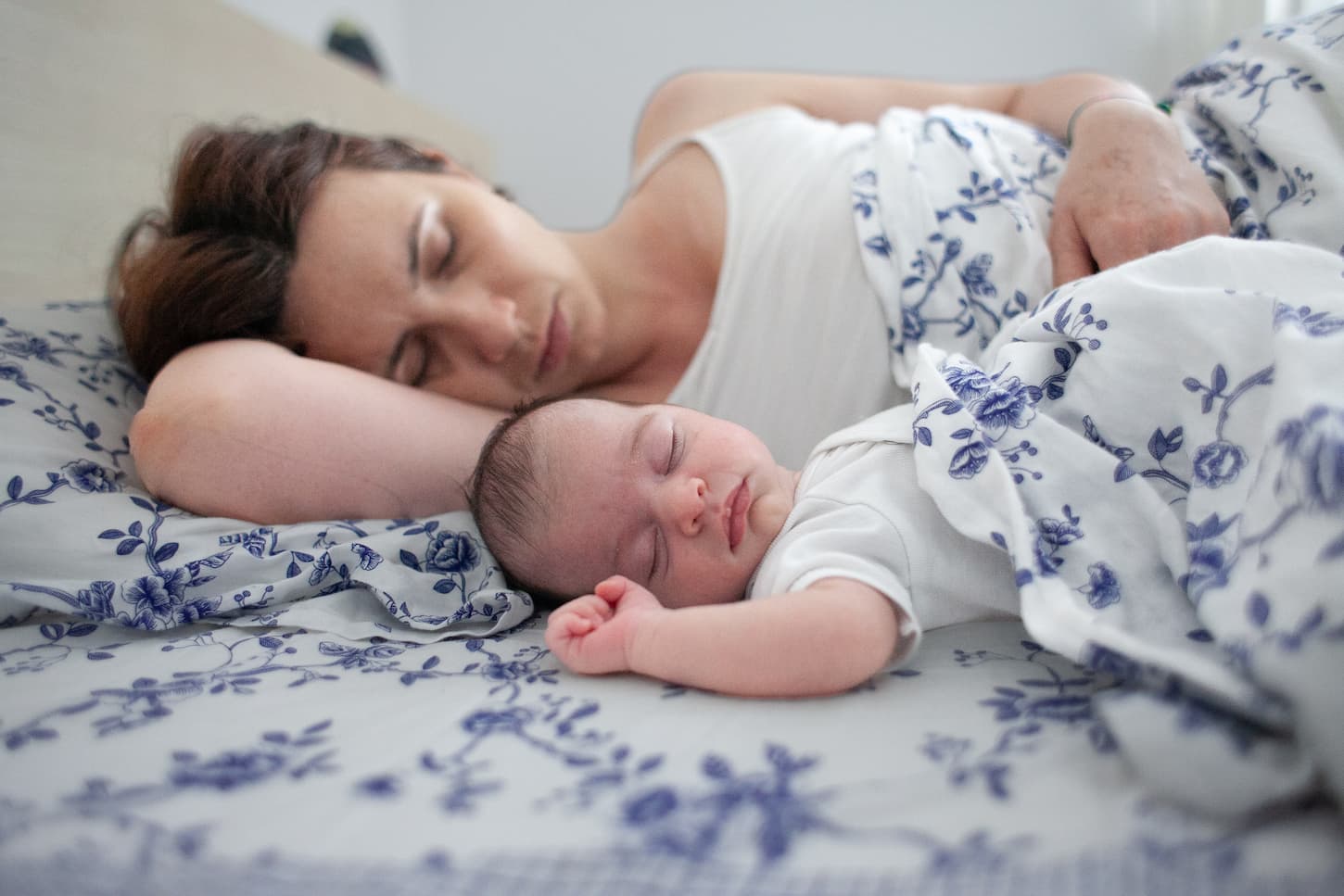With our older kids, I used to wonder if there would ever be a way to avoid sleep regressions – especially when I was up at night with them. Can sleep regressions be avoided? And if so, how do you do it?
Some sleep regressions can be avoided while others can be significantly shortened through preparation, sleep training, and healthy sleep hygiene practices.
There are so many factors that can influence whether or not your baby is able to skip (or stop) a sleep regression. Even so, let’s talk about how exactly to skip a sleep regression – or at least stop it in its tracks.

How To Avoid Sleep Regressions
Once you know what causes sleep regressions, it is possible to avoid some of them. The odds of avoiding every regression, however, are pretty small. Odds are you’ll still hit at least one of the major sleep regressions.
- Know what events commonly trigger sleep regressions.
- Make a plan to manage those triggers that you can control.
- Plan to delay exposure to triggers that you can and want to avoid.
- Create a positive and consistent sleeping environment.
- Use regular routines for bedtime and nap times that prepare your child for sleep.
- Practice good sleep hygiene.
- Use preemptive, behavioral-based sleep training.
Now, let’s look at our list in more detail. Step one is knowing what causes or triggers sleep regressions. It’s so important that we covered those triggers before we even learned how to avoid sleep regressions.
So, let’s keep going through our list, talk specifics, and cover some examples.
1. To Avoid Sleep Regressions, First Know What Causes Them
Before we can skip or stop sleep regressions, we have to know what causes them. That way, we can address the underlying cause rather than applying a band-aid fix that doesn’t work (and leaves everyone more frustrated).
Sleep regressions are most often associated with major developmental milestones or a significant change that disrupts their sleep patterns, like a time change. So what causes sleep regressions? Here’s a list of causes:
- Biological developmental milestones
- Baby learning new developmental tasks (rolling over, sitting up, crawling, walking, etc.)
- Development of separation anxiety
- A child’s expression of control over their environment
- Teething pain
- Removal of negative sleep associations
- Time changes
- Travel or vacation
- Illness or sickness
Beyond that, there are some important factors that address how long sleep regressions can last. For my full article on how long sleep regressions last, and the factors that affect the length, click here. But because it’s always nice to not have to switch pages, here’s a summary list:
- the child’s nature, personality, or disposition;
- how well the baby sleeps normally;
- where everyone sleeps;
- the family’s situation;
- parents’ interventions or parenting style;
- quantity and quality of help the family can rely upon;
- what caused the sleep regression;
- any related underlying medical issues;
- and any other surprise factors that may pop up.
In other words, there are a ton of factors that can impact a child’s sleep – and each of these alone can trigger a sleep regression. When multiple factors become involved, sleep regressions are practically guaranteed to happen.
Example: One year when our oldest was about 9 months old, we took a trip out of state to visit family. Between the time change, an 11-hour drive, and the new environment, we were expecting our baby (who did not react well to any changes in his sleeping environment) to have a sleep regression. He didn’t disappoint.
2. Make a Plan to Manage Triggers
Now that you know which of the triggers commonly cause sleep regressions, take a look at them. If you aren’t sure which ones will cause a problem for your kids, start by looking at which ones cause sleep disruptions for you.
Any events that mess with your sleep will probably trigger a sleep regression in your baby.
Then, make a plan to better manage that trigger.
Example: After realizing that Daylight Savings was a reliable event that triggers sleep regressions for our baby, we built a plan to manage the transition better. For our children who aren’t yet in school, we start adjusting their daytime schedules by 10 minutes at a time the week before Daylight Savings happens. This way, by the time Daylight Savings does kick in, we’re already adjusted and we’ve skipped the sleep regression.
Example: For our kids that are in school, we instead pre-adjust our clock by 15-20 minutes over 2-3 days. This way, we still avoid the issues but we aren’t causing any issues with school schedules or extracurricular activities.
3. Plan to Delay Exposure to Triggers You Can and Want to Avoid
Next, take another look at the factors that cause sleep regressions. In some cases, it may be worth your time to make a plan to avoid these factors to the best of your ability – at least for a short time.
Example: When our second son was a baby, we took another trip to visit family. It ended just as badly as the first did, so we decided to delay future long-distance, time-changing family trips until after our children’s sleep schedules had become more reliable.
Now that our children are all over 2 years of age and are better sleepers, we’re not as worried about sleep regressions. So we’re finally back to the point where we’re okay with planning another visit out-of-state to visit family on an extended vacation.
In any case, I know that avoidance isn’t a long-term coping strategy. But it can be very useful as a short-term, temporary way to better manage sleep regressions so that your family can get the rest they need to be functional.
4. Create a Positive and Consistent Sleep Environment
While some of us can fall asleep almost anywhere, some people require a consistent, positive sleep environment in order to get the best sleep possible. So create as consistent, positive, and reliable a sleep environment as possible.
Example: Our kids sleep better in a cool, calm, and quiet environment. We’ve used external sleep associations like white noise machines, blackout curtains, and fans to create an ideal sleep environment for our kids so that they can get the sleep they need.
Most people sleep better in a controlled environment. So go ahead and set that environment up to help your family see sleep success.
5. Use Regular Routines for Bedtime and Nap Times
While some people do well on a schedule that changes frequently, most people do better on a regular routine. It’s the exact same situation for our children and sleep.
Even so, I know that it’s really hard when your schedules vary from day to day. So whether your actual bedtimes stay the same every night or they change, make the bedtime routine itself the same.
Example: When I worked night shifts at the hospital as an ER nurse, we created a “mommy’s going to work, so let’s say goodnight” routine. Then, my husband would use the regular bedtime routine once it was time for our kids to go to bed.
Now, daytime naps and nap time routines can be more different – especially if daycare is involved.
Example: When I worked day shifts, my friends and family alternated watching my children. I shared what sleep tips worked best for my kids, but I also knew that the caregiver would make the final decision as to how the routine would play out. Also, since naps weren’t happening in the usual space, I knew that naps would be shorter and less restful. For the next few days, I adjusted nap times while continuing the regular routine to help prevent daytime sleep regressions.
In other words, create and use the routine and schedule. Then, create a backup schedule for recovering from days or situations when you can’t stick to the preferred, primary schedule.
6. Practice Good Sleep Hygiene
Next, help your kids practice good sleep hygiene. While this may help you avoid sleep regressions, it will definitely help you keep sleep disturbances to a minimum.
Good sleep hygiene practices include:
- Keeping naps separate and distinct from nighttime sleep. For adults, this can mean limiting naps to 30 minutes. For babies, this means keeping the last nap of the day at least 30-60 minutes before bedtime.
- Eating healthy foods and avoiding foods that can be disruptive to sleep. Eating heavy or fatty foods may cause indigestion or heartburn while sleeping.
- Avoid stimulants close to bedtime. Fun fact: kids should be avoiding caffeine altogether (it can cause heart dysrhythmias in children). So skip the heart problems and sleep disruptions: skip the caffeine.
- Use natural light to guide your day and maintain your natural sleep-wake cycle. Watching TV or using a device before bed can disrupt that natural sleep-wake cycle. Children should ideally be avoiding screen time before age 2 anyway.
- Create a healthy and pleasant sleep environment.
- Exercise during the day to promote quality nighttime sleep. Avoid strenuous exercising too close to bedtime. For babies, tummy time or playing is their exercise, so keep it light before bedtime.
Good sleep hygiene practices can be used throughout life to get better sleep, no matter your age.
Example: My kids sleep better if we have an active, fun, and full morning’s worth of activities. Then, we have an after-lunch rest or nap time. That’s followed by more activities, exercise, and fun. Then, we try to keep after-dinner activities more mellow so that we can start preparing for bedtime.
7. Use Preemptive, Behavioral-Based Sleep Training
The last step to avoiding sleep regressions is to use preemptive, behavioral-based sleep training on a regular basis.
Example: When I know a sleep regression trigger is about to happen, we fall back to our tried-and-true sleep training habits. That way, we’re reinforcing the best habits and we can all focus on getting better sleep.
Now, this doesn’t mean I fall back to crying it out – that’s not a behavioral-based sleep training technique. Instead, we:
- review our sleep routines to make sure that we’re using positive external sleep associations;
- reinforce positive sleep associations;
- and remove negative sleep associations.
And because we’re focusing on these factors on a regular, reliable basis, I guess you could technically say we’re constantly sleep training. I prefer to think of it as us being super-dedicated to a good night’s sleep now – so that it’s an ingrained habit later on.
Example: My school-aged kids are beginning to realize when sleep is becoming an issue; after a trip, they request that we get back to our regular bedtime routines so that everyone gets better sleep. I’m so excited when they do this – all of our hard work is paying off!
Using all 7 of these tips will help you avoid some sleep regressions. And, when used in conjunction with a few more tips, you’ll be able to stop the ones you can’t avoid.

How To Stop Sleep Regressions
Again, you’re not going to be able to avoid every sleep regression. I’ve talked to more than 800 other parents who are in the same boat – they’ve been able to avoid some sleep regressions, but not all of them.
Even so, when we combine the above 7 tips with these next 4 steps, it is possible to put an earlier stop to the sleep regressions we can’t avoid. So here’s what you need to do to stop sleep regressions:
- Create a positive and restful sleeping environment.
- Be consistent in all of your sleep training efforts.
- When experimenting with changes to the sleeping status, only change one or two factors at a time.
- Use a bedtime and nap routine that helps ease each person into a sleep-ready state.
Okay, so steps 1 and 4 are also in the 7 steps to avoiding sleep regressions we already talked about. However, they’re so important that I had to list them again. Because if you only read this section on how to stop sleep regressions, they’re too important to miss.
Then, it’s important to be consistent in all of your efforts, otherwise, the new sleep habits aren’t going to stick.
Example: It takes a few days for any new habits to take effect. With our kids, it took an average of 2-3 weeks to see the optimal results from behavioral-based sleep training.
Then, keep in mind step 3: whenever you’re experimenting with changes to the sleep status quo, only change one thing at a time. That way, you can still avoid (or stop) sleep regressions.
Example: Our kids sleep better when they’ve got a roommate. But when we first moved our toddler in with an older sibling, we didn’t also switch them to a toddler bed. We moved their crib into the room first – giving them time to adjust to the new room. Once they’d had a few weeks to adjust to the new room, then they graduated to the new bed in the now-familiar bedroom.
This way, you’ll be able to nip sleep regressions in the behind so that they aren’t as disruptive as they otherwise would be. They’ll be shorter, easier to deal with, and over before you know it.
Related Questions
How Long Do Sleep Regressions Last? Sleep regressions can last anywhere from a few days up to 6 weeks, with an average sleep regression lasting 2 weeks. For more details (including examples), read my article on how long sleep regressions last.
Why Do Sleep Regressions Happen? Sleep regressions are sleep disruptions that happen when your baby experiences an event (like a milestone or a life change) that affects their sleep patterns.
Do All Babies Go Through a Sleep Regression? Not all babies go through every sleep regression. Some babies will have fewer sleep regressions and others will have more.
